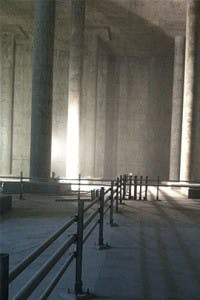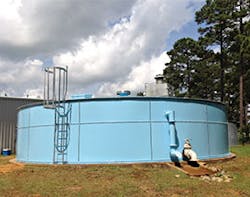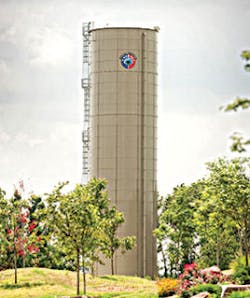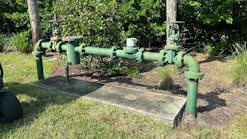Visitors on the grounds of any water utility that uses General Electric’s ZeeWeed water filters may notice something slightly unusual: rectangular water tanks. The ZeeWeed filters themselves, a curious collection of spaghetti-like tubes, dangle in large blocks hoisted overhead by intense-looking track systems. When those track systems drop the tubes into tanks that resemble open-topped shipping containers, they fill nearly all of the space. That, according to Derek Senior, Municipal Systems Product Manager with GE’s power and water division, is by design. The ZeeWeed tubes tend to float. If the tank they occupy allows too much extra space, the filters can drift out of place and lose their effectiveness.
Senior’s unit helps districts design and install their ZeeWeed holding tanks, a task that comes with a unique collection of engineering challenges that all spring from the filter system’s tight tolerances. A collection of ZeeWeed filter modules can be close to 6 feet wide and as long as a shipping container, and the surrounding tank must meet those dimensions within 1 inch. By definition that rules out round tanks, and rectangular tanks introduce another complication.
“When you put water in a vessel, it wants to round out the tank naturally,” says Senior. The default height of a ZeeWeed module is 86.4 inches—just more than 7 feet—and that depth means that a freestanding tank will need thick walls and strong brackets.
Plant managers should also pay close attention to the materials that they use. For smaller tanks (up to the size of a shipping container), Senior suggests stainless steel. GE, which can provide pre-built tanks for its filtration system, formerly offered the option of less expensive epoxy-coated carbon steel tanks. But Senior finds those tend to need maintenance more quickly.
“All it takes is a chip or two on that surface, and you can get some real rusting and corrosion,” he says.
In larger-scale installations, GE’s customers often build concrete tanks. Again, these must observe tight tolerances, which may be complicated by local water conditions. Acidic or salty water conditions, Senior notes, can erode the surface of concrete, which can make the tank expand beyond the system’s tolerances. Installing a coating can solve this problem, but it must be done properly. Any gaps in the surface could allow the corrosive water to seep through and damage the tank. Additionally, if the utility operates in a moist atmosphere, facilities managers must be careful to keep the exterior of the tank dry. Concrete is porous, and any moisture that’s allowed to seep through can push off the protective coating.
Senior notes that ZeeWeed systems are rated to last for 10 years, but some of his customers have seen their systems last for as long as 15. GE is also careful, he says, to make sure that advancing technology doesn’t require its customers to change physical installations like water tanks. For these reasons, he says, it makes sense to invest more during the initial installation of a storage or containment vessel to save money in the long run. Any corners cut at the time of installation may haunt the utility for decades to come.
This advice also works more generally. Containment and storage occupy many roles in the municipal water industry—ranging from reservoirs to water towers, to holding tanks at treatment plants. While the challenges and vendors for these applications differ, storage and containment professionals tend to agree on one thing: investing a little more up front will probably save the utility money in the long run. Most of these vessels will remain in service for decades. Keeping their maintenance requirements low will save money and minimize operational disruptions.
Reservoirs
The Quabbin reservoir, about 65 miles west of Boston, covers an area of roughly 39 square miles and holds more than 400 billion gallons of water. Water departments in the city and 40 other surrounding communities draw from the Quabbin to meet their customers’ daily needs. It was built between 1930 and 1939 by flooding a valley that once contained four different towns. These days, water utilities would likely never be allowed to take such extreme measures to hydrate their population. Instead, they often resort to digging large, artificial reservoirs on empty land that’s not necessarily ideal for keeping water in.
The inside of a tank at Estates Reservoir, CA
Large, earthen holes tend to leak water, according to Steve Roades, vice president of Burke Industries. Lining the hole with asphalt or concrete can reduce the rate at which the reservoir leaks, but both materials are susceptible to cracks as temperatures change and seismic activity moves the Earth. His company supplements (and, in some cases, replaces) these measures by lining reservoirs with a rubberized material called a geomembrane.
The material comes in sheets that workers stitch together onsite into one contiguous surface. The continuity of the surface prevents leaks, and its flexibility keeps it from cracking during earthquakes. This also lends a degree of structural stability–which is sometimes an important bonus. Roades notes that his company supplied a liner for a 58-acre reservoir for Monterey, CA. The city resides in an earthquake-prone region, and its reservoir sits atop a hill just outside of town. Should the sides of the reservoir ever break, the event would have disastrous consequences for the city.
His company’s product, he says, differs from others in that it uses a material called Hypalon–a kind of polyethylene.
“It’s not cheap. We are the most expensive geomembrane out there,” says Roades, “[but] the longevity of this product stands on its own.”
Burke’s competitors use other materials, such as reinforced polypropene, which are less expensive but also less
Smaller tanks may hold chlorine or be used in wastewater treatment.
durable–which could increase a utility’s large-scale disruptions. Repairing a geomembrane liner, Roades says, is a major undertaking. It requires first that the reservoir be “dewatered”—basically drained to nothing. For at least one of Burke’s reservoir customers, that would mean draining 128 feet of water. If a utility draws from only one reservoir, this would mean high repair costs, a serious operational distraction and the additional burden of buying water from a nearby utility (if possible).
If a utility draws water from multiple smaller reservoirs, this may be less of an issue, and less expensive liners may be more attractive. But, for utilities entirely reliant on a single reservoir, utility managers will likely want to invest the additional capital and get a liner that will last several decades. The liners Roades sells, he notes, last as long as 30 years. He’s been with Burke industries for more than three decades, he says, and he has only had the opportunity to sell new liners for his previous installations a handful of times.
In many cases, Roades’ sales include not only reservoir liners, but also “floating roofs.” The federal Clean Water Act and its implementation on the state level requires that reservoirs either be covered or have their water treated for waterborne parasites before it can be delivered to customers. While utilities in wet areas—such as Boston’s Quabbin reservoir or Reservoir No. 1 at Pittsburgh’s Highland Park—have opted for treatment, utilities in dryer areas tend to opt for covers.
USA Tank will provide utilities with tanks up to 5 million gallons.
The combination of liner and floating roof effectively turns the reservoir into an enormous bladder that takes in water and lets it out only on demand. The typical roof Roades sells is about 300,000 square feet (roughly the size of 10 football fields), but they can be much larger. In one case, he says, his company was involved in the installation of a roof that covered 1.2 million square feet. That’s the equivalent of 40 football fields—enough to supply dedicated practice space to every NFL team with eight additional fields to spare!
In addition to keeping out waterborne pathogens, the floating roofs keep the water from evaporating.
“If you’re looking at an open-top reservoir that’s holding 280 million gallons of water, the evaporation rate is actually staggering,” says Roades.
While evaporation prevention is a meaningful benefit for utilities in dry areas, utilities in damper areas may have other reasons to want a floating roof. LOOP-LOC, the same company that makes the pool covers capable of holding the weight of an elephant, also makes floating covers for work on reservoirs.
Unlike Burke’s reservoir covers, LOOP-LOC’s don’t cover the entire surface of the reservoir. Instead, they float like a raft and cover small areas. This could be to keep out swimmers, says Maryellen Comitino, director of sales for LOOP-LOC, or to help utility workers who have to work on the reservoir; the floating surfaces are sturdy enough to support the weight of many tools.
At the Treatment Center
While LOOP-LOC occasionally sells covers for reservoirs, their main entry into the public water industry comes at water treatment facilities. Utilities may sometimes need to place open-topped treatment tanks in outdoor settings, which introduces certain challenges—mainly, the threat of contaminants such as bird droppings or falling leaves. Senior with GE Power and Water notes that utilities in warm areas sometimes set up his company’s ZeeWeed filters outside, as they require a large amount of overhead space to accommodate the track system that raises and lowers the membranes.
When covering exterior tanks, Comitino says, water utilities have two basic choices: rigid systems made of a material such as aluminum, or fabric and wire systems like the ones her company offers. Metal systems tend to be heavier and more cumbersome, Comitino says, though both can be made to fit individual needs.
Whether the utility chooses flexible or rigid covers, they must make sure that their covers do not react with water. An aluminum cover would need an additional coating to prevent corrosion. LOOP-LOC’s covers are made of a non-reactive material, Comitino says, which can also be semi-permeable if the utility wishes it to be.
“Some customers want the rain water to go through,” she says. “Our dense mesh will keep larger debris out, but mostly will let rainwater go through.”
The covers can also be designed to accommodate angles—which may be necessary if the tank includes pipes or equipment that exceeds the height of the tank’s edge. When dirty, Comitino says covers, like the ones she sells, can simply be hosed off.
Aside from bird droppings and leaves, she says, cover systems are also good at keeping workers and tools from falling into the water, but they don’t have to keep workers away from the equipment they need to access. Custom flexible cover systems can be designed with access cutouts and can be anchored either to the tank itself, or the surrounding ground. The choice of anchor point can help as conditions differ by location. If, for example, a utility had two tanks positioned immediately adjacent to each other, LOOP-LOC could design ground-anchored cover to jointly cover both tanks. If the tanks were adjacent but had an oft-used catwalk between them, the company could design individual, tank-anchored covers for both.
In some cases, facilities managers may also be concerned about security. While vandals or would-be terrorists have never succeeded in poisoning an American public water supply, that doesn’t mean they haven’t tried to do so. Rigid cover systems tend to repel that kind of attack through their sheer weight; unless the vandal knows how to access certain areas, the cover will be difficult and cumbersome to move. Flexible systems offer a similar level of protection, Comitino says. The covers tend to cling tightly to the edge due to the tension between the cover and its anchor. To gain access, the criminal would need to sever several anchoring wires, which may give security or authorities enough time to respond to the incident before any damage is done.
Water utilities also have meaningful choices to make with regard to the tanks they use at their treatment facilities. While facilities managers may, by default, think of all water tanks as round, they don’t need to be. In the case of the ZeeWeed installation mentioned above, the filtration tanks need to be rectangular, otherwise the rounded sides will allow too much space for the long, narrow tubes to float out of place. Rectangular tanks also offer advantages to those utilities that are squeezed for space; collecting a number of circular tanks next to each other will inevitably leave wasted empty space between the tanks. Collecting rectangular tanks, GE’s Senior notes, allows two tanks to share the same wall and eliminates empty space. He notes that rectangular tanks are also useful in settings where a utility might want to create flow between one tank and another.
Even with round tanks, utilities have choices to make. USA Tank, for example, will provide utilities with tanks up to 5 million gallons, but anything greater than 112,000 gallons will have to be assembled onsite. According to Richard Russ, USA Tank’s director of sales, the limiting factor on delivering fully assembled shop-welded tanks is what will fit on the back of a tractor trailer. These tanks will, typically, not be large enough to suit most utility’s water storage needs, he says, but they may be useful in the water treatment process or for holding chlorine.
Russ says his company sells many of these tanks—particularly those with cone-shaped or sloped bottoms–for use in wastewater treatment facilities. The narrow base creates an area where particulate and sludge can collect before it’s pumped out.
Installing a large tank also doesn’t need to require a utility to remodel its treatment facility. USA Tank in particular, Russ says, can erect bolted flat-panel tanks in place through a jacking process where each section is built at ground level and then lifted up. This process minimizes any disruption to operations and allows new tanks to be built in tight spaces.
Potable Storage
While Russ sells some larger sized tanks to water treatment facilities, he says he sells most of them for use as potable water storage. Here, utilities have three main choices: water towers, tall “standpipe” water tanks, or wide and flat “ground” storage tanks. Towers are generally used to both store water, and supply pressure during times when the utility can’t or doesn’t want to use its pumps—perhaps for peak-shaving purposes. Standpipes, he says, can serve a similar purpose while also storing a larger quantity of water.
“In Arkansas, I’ve done a lot of standpipes,” says Russ. “The tall, skinny ones, they use those for pressure.”
The main determining factor on whether a utility should use a standpipe or a ground storage tank, Russ says, is geography. Utilities in Arkansas build their standpipes atop hills. In West Texas, where the desert landscape stretches for miles with scarcely a change in elevation, utilities favor wide and flat tanks.
“The economics favor the ground storage tanks,” says Russ.
Here, again, utilities have a choice between stainless steel and coated carbon steel. Stainless steel is both more expensive, and more resilient, Russ says, but appropriately coated carbon steel tanks may still work for passive post-treatment storage. While Senior at GE notes that it only takes a small chip in the coating of a submerged carbon-steel surface to create a meaningful rusting problem, that’s less of an issue in water storage. Tanks in a treatment facility will be exposed to potential dings on a regular basis as workers toil in the area. Tanks holding post-treatment potable water are left unmolested most of the time.
Onsite Storage
When a water utility is stretched to its capacity, it may sometimes make sense to mitigate demand on the system by moving some of the responsibility onto the systems users. When a developer wishes to install a new, large-scale commercial center or cluster of houses, for example, it may make sense for local regulators to require that they handle their waste onsite.
“If you’re a land developer…you may have a real difficult time getting a permit from the system to send 300 houses’ worth of waste to the treatment plant that’s already at capacity,” says Tom Tietjen, vice president of sales and marketing for Xerxes Corporation.
In those cases, the developer will need underground tanks like those Xerxes sells. Tietjen says his company saw a lot of business from housing developments during the housing boom, but the traffic has tailed off in the last five years as the economy has struggled.
While commercial developments may want to go the same route, local water utilities may have other reasons to encourage commercial developments to buy large water tanks: onsite rainwater capture. If a new development should install a rainwater collection system, it could both reduce rainwater runoff and ease the development’s demand for water. With proper installation, the development’s landscape managers can use the captured “graywater” to irrigate grass and other plants.
In some cases, utilities may even want to encourage new and existing residential customers to install smaller-scale rain capture systems. While runoff doesn’t tend to be as pressing of a problem in residential settings (in suburban areas, most homes are surrounded by an abundant and absorbent landscape), the captured and reused water could ease demand.
Mike Ruck, cofounder of Rain Water Solutions, says that he has sometimes worked with local utilities to help distribute his company’s rain barrels to the utility’s residential customers. In some communities, the utility or a community group will keep the rain barrels in stock for when people ask for them. In others, he might help organize a “one-day distribution” similar to a hazardous materials return day.
“[For the] agencies that are talking on these kinds of events, this is typically not in their job description,” says Ruck. “They’re usually going beyond their normal responsibility.”
Ruck also notes that some water utilities are uninterested or even hostile to rain barrel programs. Because of fixed costs inherent in supplying water to the public, any conservation effort that significantly reduces water consumption may force the utility to raise its rates.
But, when a water system is at its limits and the town government approves new homes, this could be the kind of measure to ease pressure on utility managers.
While shortcuts like this can help a utility get through the next few years, utility managers know that when it comes to long-term solutions, they should invest as effectively as they can. Reservoir liners, floating roofs, and storage tanks will be with the utility for more than a decade—and often several decades. Any money the utility saves up front by going with a lower-quality option could cost them heavily just a few years later. So, invest accordingly.









